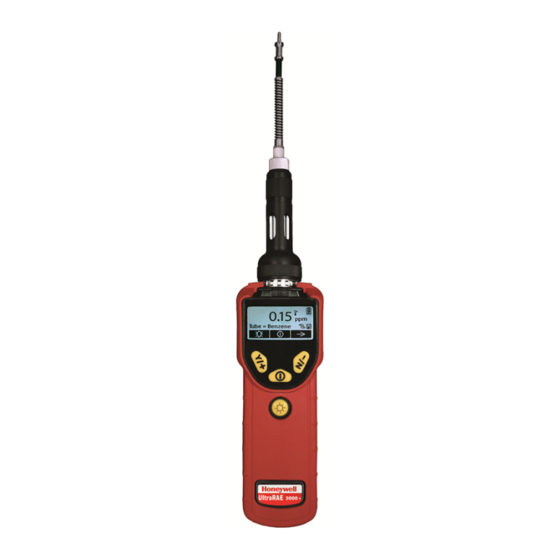
Table of Contents
Advertisement
Quick Links
Advertisement
Table of Contents

Summarization of Contents
CHAPTER 1 INTRODUCTION
Product registration
Register your product online to receive notifications for upgrades, enhancements, and special offers.
Standards and certifications
Details on intrinsic safety approvals and certifications relevant to the instrument.
Safety and Precautions
Essential safety warnings and guidelines for using the instrument safely.
Standard package contents
List of accessories and items included with the instrument upon purchase.
CHAPTER 2 GENERAL INFORMATION
Key features
Highlights of the instrument's capabilities and benefits, such as portability and accuracy.
Physical description
Overview of the instrument's main components and physical attributes.
CHAPTER 3 CHARGING THE BATTERY
Charging procedures
Step-by-step guide on how to charge the instrument's rechargeable battery.
Battery warnings and types
Information on battery safety, types (Li-ion, Alkaline), and low voltage alerts.
CHAPTER 4 BASIC OPERATION
Turning the instrument on and off
Instructions for powering the instrument on and initiating the shutdown sequence.
CHAPTER 5 USER INTERFACE
Display overview
Explanation of the instrument's LCD display elements and readings.
Understanding instrument icons
Guide to interpreting the various icons displayed on the instrument screen.
CHAPTER 6 OPERATING THE INSTRUMENT
Instrument startup and shutdown
Detailed steps for turning the instrument on and off, including self-tests.
Auto-zero and flashlight usage
How to use the auto-zero function and the built-in flashlight.
CHAPTER 7 OPERATING MODES
MiniRAE 3000+/ppbRAE 3000+ Modes
Explanation of different operating modes for these specific models.
UltraRAE 3000+ Operation Modes
Description of the various modes available for the UltraRAE 3000+.
CHAPTER 8 ULTRARAE 3000+ OPERATION
Compound-specific measurement
How to perform measurements for specific compounds using separation tubes.
Measurement process
Steps involved in performing a compound-specific measurement, including tube preparation.
CHAPTER 9 VOC OPERATION - ULTRARAE3000+
Basic user level/hygiene mode
Default operational mode providing essential features for routine use.
CHAPTER 10 ALARM SIGNALS
Alarm signal summary
Overview of different alarm messages, conditions, and corresponding signals.
Preset alarm limits and testing
Default alarm settings and how to test the instrument's alarms.
Datalogging Features
Datalogging setup and types
How to configure and use the instrument's datalogging capabilities.
Interval and data selection
Setting datalogging intervals and choosing which data types to record.
CHAPTER 11 STANDARD KIT & ACCESSORIES
Included Accessories
List of standard accessories provided with the instrument for different models.
Optional Accessories
Description of additional accessories available for purchase.
Battery Management
AC adapter and charging
Details on using the AC adapter for charging the instrument's battery.
Alkaline battery adapter
Information on using the alkaline battery adapter as an alternative power source.
CHAPTER 12 CALIBRATION
Standard two-point calibration
Procedure for performing zero and span calibration on the instrument.
Zero and Span calibration procedures
Detailed steps for performing zero and span calibrations.
CHAPTER 13 Three-point calibration
Span 2 calibration process
Steps for conducting the second span calibration in a three-point calibration.
CHAPTER 15 PROGRAMMING MODE
Entering and navigating programming mode
Steps to enter and move through the instrument's programming menus.
Programming mode menus
Overview of the different menus and sub-menus available in programming mode.
CHAPTER 16 HYGENE MODE
Basic user level & hygiene mode
Default mode for basic functionality and automatic measurements.
Entering search mode
How to switch from Hygiene Mode to Search Mode via programming.
CHAPTER 17 ADVANCED USER LEVEL
Advanced user level modes
Description of the advanced user level, allowing more parameter changes.
CHAPTER 18 DIAGNOSTIC MODE
Entering and using diagnostic mode
How to access and use the diagnostic mode for servicing.
Adjusting pump stall threshold
Procedure for tuning the pump stall threshold for optimal performance.
CHAPTER 19 TRANSFERRING DATA
Downloading datalog to PC
Steps to transfer logged data from the instrument to a computer.
Uploading firmware from PC
Instructions for updating the instrument's firmware from a PC.
CHAPTER 20 MAINTENANCE
Battery maintenance
General care and replacement procedures for the instrument's battery.
PID sensor and lamp care
Cleaning and replacement guidelines for the PID sensor and lamp.
Pump and instrument cleaning
Procedures for cleaning the sampling pump and the instrument exterior.
CHAPTER 21 SPECIFICATIONS
MiniRAE Lite+ Specifications
Technical details including size, weight, detector, battery, and display.
MiniRAE Lite+ Measurement Range & Resolution
Specifics on measurement capabilities for the Lite+ model.
MiniRAE Lite+ General Specifications
Broad technical data like response time, accuracy, and communication.
MiniRAE 3000+ specifications
MiniRAE 3000+ Measurement Range & Resolution
Specifics on measurement capabilities for the 3000+ model.
MiniRAE 3000+ General Specifications
Broad technical data like response time, accuracy, and communication.
ppbRAE 3000+ specifications
ppbRAE 3000+ Measurement Range & Resolution
Specifics on measurement capabilities for the ppbRAE 3000+.
ppbRAE 3000+ General Specifications
Broad technical data like response time, accuracy, and communication.
UltraRAE 3000+ specifications
UltraRAE 3000+ Measurement Range & Resolution
Specifics on measurement capabilities for the UltraRAE 3000+.
UltraRAE 3000+ General Specifications
Broad technical data like response time, accuracy, and communication.
CHAPTER 22 TROUBLESHOOTING
Common operational problems
Troubleshooting common issues like power, password, and abnormal readings.
Error messages and solutions
Addressing specific error messages like "Lamp" or "Sen" and their resolutions.
Contact Information
Corporate Headquarters
Contact information for Honeywell's main corporate office.
Worldwide Sales Offices
Contact details for Honeywell's regional sales offices globally.










Need help?
Do you have a question about the MiniRAE Lite+ and is the answer not in the manual?
Questions and answers